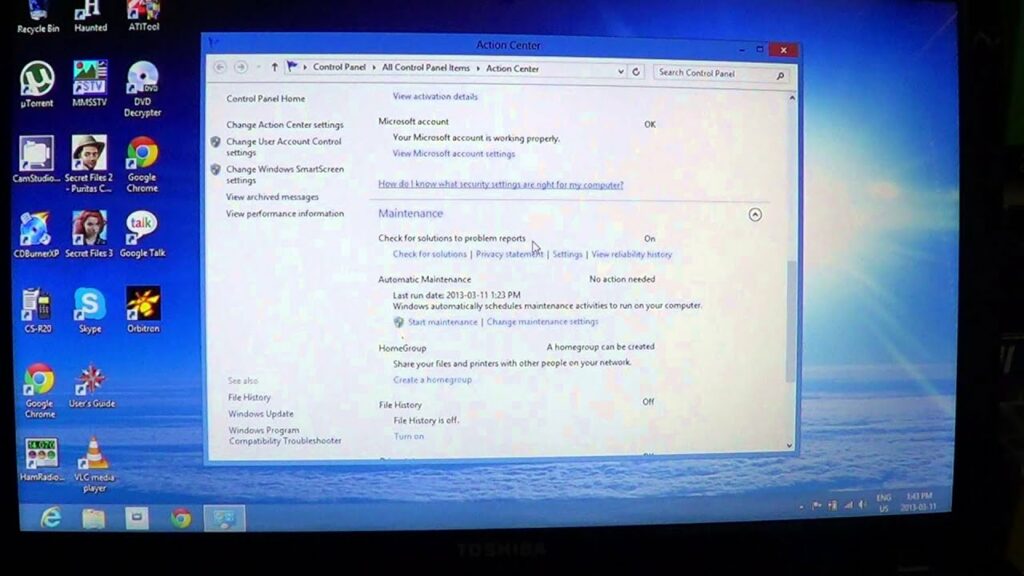How to use Windows Action Center in Windows 8

In Windows 8, the Action Center serves as a centralized hub for system notifications, alerts, and maintenance tasks, helping users stay informed about the status of their computer and take necessary actions to ensure optimal performance and security. The Action Center monitors various aspects of your system, including Windows Update, security settings, maintenance tasks, and system health, providing notifications and recommendations to help you address potential issues and keep your system running smoothly. Understanding how to use the Action Center effectively is essential for maintaining the health and security of your Windows 8 computer. In this comprehensive guide, we’ll explore everything you need to know about using the Action Center in Windows 8, from accessing its features to interpreting notifications and taking appropriate actions to resolve issues and optimize system performance.
Accessing the Action Center:
To access the Action Center in Windows 8, follow these steps:
- Open Action Center: Click or tap on the Action Center icon in the system tray/notification area on the taskbar. The Action Center icon resembles a white flag with a red “X” or a white checkmark, depending on whether there are pending notifications or issues.
- Alternatively, Access via Control Panel: You can also access the Action Center through the Control Panel. Open the Control Panel by pressing the Windows key to open the Start menu, then typing “Control Panel” and selecting it from the search results. In the Control Panel, navigate to “System and Security” > “Action Center.”
Understanding Action Center Notifications:
The Action Center provides notifications and alerts for various system-related events, including:
- Security: Notifications about antivirus and antispyware programs, Windows Firewall, and other security settings.
- Maintenance: Notifications about system maintenance tasks, such as Windows Update, disk cleanup, and troubleshooting options.
- Backup and Restore: Notifications related to Windows Backup and Restore settings, including backup status and recommendations for backing up important files.
- Troubleshooting: Notifications about system errors, warnings, and issues that require user attention or intervention.
Interpreting Action Center Notifications:
When you open the Action Center, you’ll see a list of notifications grouped by category. Each notification includes information about the event or issue, as well as recommended actions to resolve it. Here’s how to interpret Action Center notifications:
- Security Notifications: Security notifications alert you to potential security risks or issues on your system, such as outdated antivirus definitions, disabled firewall, or unrecognized programs. Follow the recommended actions to address security concerns and ensure that your system is protected against threats.
- Maintenance Notifications: Maintenance notifications inform you about pending maintenance tasks, such as Windows updates, disk cleanup, or disk optimization. Follow the recommended actions to keep your system up-to-date and running smoothly.
- Backup and Restore Notifications: Backup and restore notifications provide information about the status of your backup settings and recommend actions to protect your data. Follow the recommended actions to set up or configure backup settings and ensure that your important files are backed up regularly.
- Troubleshooting Notifications: Troubleshooting notifications alert you to system errors, warnings, or issues that require attention. Follow the recommended actions to troubleshoot and resolve the reported issues, such as driver conflicts, hardware failures, or software compatibility problems.
Taking Action in the Action Center:
To address issues or take action on notifications in the Action Center, follow these steps:
- Review Notifications: Review the list of notifications in the Action Center and click or tap on each notification to view more details and recommended actions.
- Follow Recommended Actions: Follow the recommended actions provided with each notification to resolve the reported issues or perform necessary maintenance tasks.
- Resolve Issues: Take appropriate actions to resolve any identified issues or address system notifications, such as updating antivirus definitions, installing Windows updates, running disk cleanup, or troubleshooting hardware/software problems.
- Mark Notifications as Resolved: After addressing an issue or completing a recommended action, you can mark the corresponding notification as resolved by clicking or tapping on the notification and selecting the appropriate option.
Customizing Action Center Settings:
To customize Action Center settings in Windows 8, follow these steps:
- Open Action Center Settings: Click or tap on the Action Center icon in the system tray/notification area, then click or tap on “Open Action Center.” Alternatively, access Action Center settings through the Control Panel by navigating to “System and Security” > “Action Center.”
- Change Action Center Settings: In the Action Center window, click or tap on “Change Action Center settings” in the left pane to customize notification options, maintenance settings, and backup settings according to your preferences.
- Configure Notifications: Customize notification settings for security, maintenance, backup, and troubleshooting notifications. You can choose to receive notifications, turn off specific notifications, or change notification behavior.
- Adjust Maintenance Settings: Configure maintenance settings to control how Windows handles maintenance tasks, such as Windows Update, disk cleanup, disk optimization, and troubleshooting options.
- Set Backup and Restore Options: Configure backup and restore settings to schedule backups, manage backup locations, and specify which files and folders to include in backups.
Conclusion:
The Action Center in Windows 8 is a valuable tool for monitoring system health, security, and maintenance tasks, providing users with notifications and recommendations to address potential issues and keep their systems running smoothly. By understanding how to access, interpret, and take action on notifications in the Action Center, users can effectively manage system updates, security settings, backup options, and troubleshooting tasks to ensure optimal performance and reliability. Whether you’re addressing security risks, performing maintenance tasks, or configuring backup settings, the Action Center provides a centralized hub for managing system notifications and maintaining the health and security of your Windows 8 computer.




